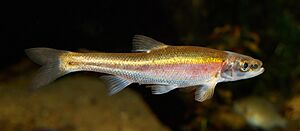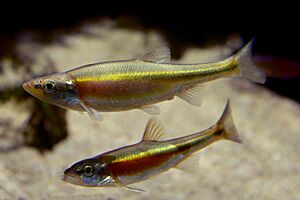Redside dace facts for kids
Quick facts for kids Redside Dace |
|
|---|---|
 |
|
| Conservation status | |
| Scientific classification | |
| Synonyms | |
|
The redside dace (Clinostomus elongatus) is a cool type of ray-finned fish. It belongs to the minnow family, called Cyprinidae. You can find this fish in streams and rivers in the United States and Canada.
What makes the redside dace special? It's the only minnow that regularly jumps out of the water! It does this to catch flying insects. This unique way of eating helps move nutrients between land and water. Because it's sensitive to changes in its environment, the redside dace can also show us if a river or stream is healthy.
Contents
Where the Redside Dace Lives
The redside dace lives in different parts of North America. It prefers clear, cool streams.
In the United States
This fish is most common in Pennsylvania. You can find it in the upper parts of the Susquehanna River. It also lives in streams that flow into all the Great Lakes. You might spot it in the Ohio River and the upper parts of the Mississippi River too.
In Canada
In Canada, the redside dace mainly lives in Southern Ontario. One special place it's found is the Two Tree River on St. Joseph Island. Most groups of these fish live in streams that flow into the western part of Lake Ontario. These streams stretch from Pringle Creek near Oshawa to Spencer Creek near Hamilton, Ontario. Smaller groups also live in areas around Lake Simcoe (like the Holland River), Lake Erie (Irvine Creek), Berczy Creek in Markham, and Lake Huron (like the Saugeen River).
What the Redside Dace Looks Like
The redside dace is a very colorful fish! It has a wide, bright red stripe that goes from its head all the way to its dorsal fin. This stripe runs along the middle of its body. Above the red stripe, there's a bright yellow stripe that goes from its head to its tail.
These colors are brightest in the spring. They slowly fade during late summer and fall. The redside dace has a very large mouth and a lower jaw that sticks out. This helps it catch insects from below. This fish can grow up to 12 centimeters long. It usually lives for about four years.
It looks a bit like the rosyside dace. But the redside dace has a longer, thinner body and brighter red colors on its sides.
Home Sweet Home: Redside Dace Habitat
The redside dace likes to live in slow-moving, cool, and clear streams. These streams are usually the very beginning parts of river systems, called headwaters. They need lots of plants hanging over the water. These plants can be grasses, small flowering plants, or low shrubs.
A perfect stream for the redside dace has both riffles and pools. Riffles are shallow, fast-moving parts of the stream. They are important for the fish when they are spawning (laying eggs). Pools are deeper, calmer areas. The fish live in these pools when they are not breeding.
Protecting the Redside Dace
Even though the redside dace is found in many places, its numbers have gone down in some areas. Some groups of these fish have even disappeared completely.
The redside dace is listed as endangered in Indiana. It was also listed as endangered in Ontario starting in 2009. It is considered threatened in Michigan. In Wisconsin, it's a "special concern" species. The Committee on the Status of Endangered Wildlife in Canada also lists it as endangered. This means we need to work hard to protect this unique fish and its habitat!




